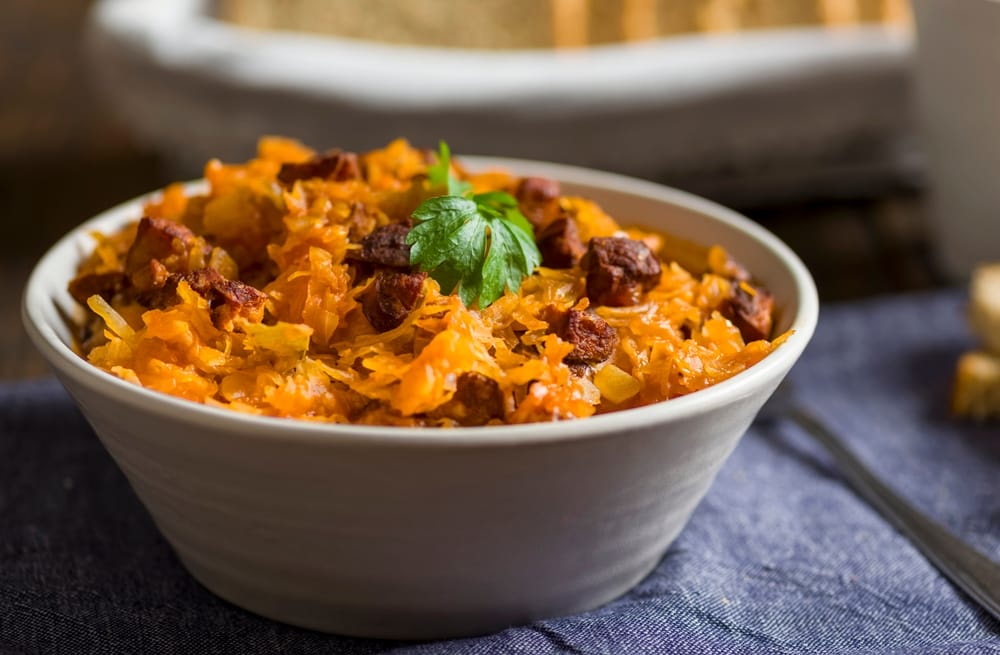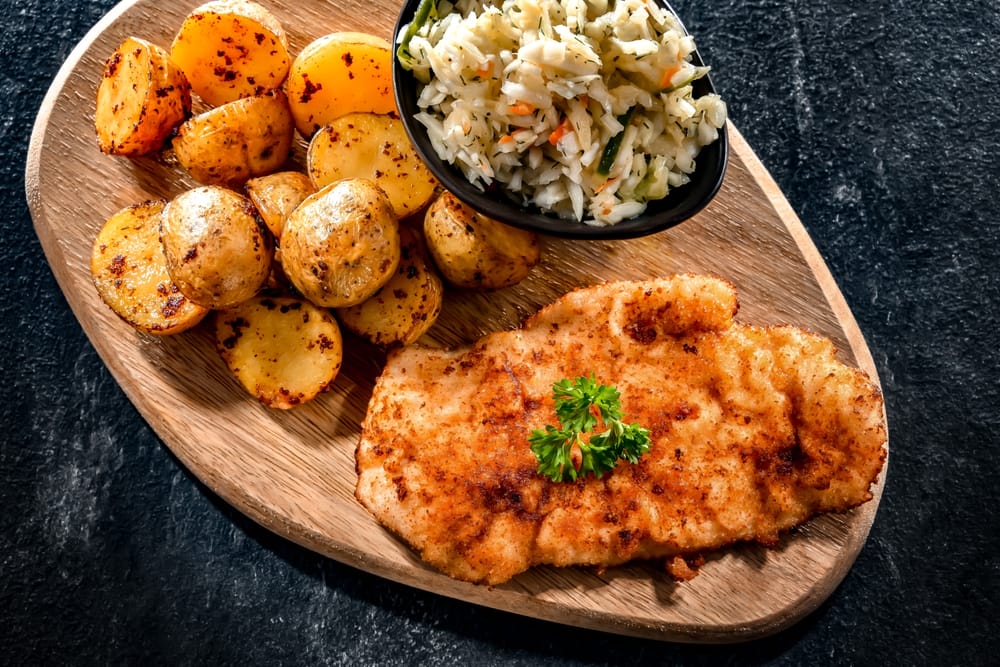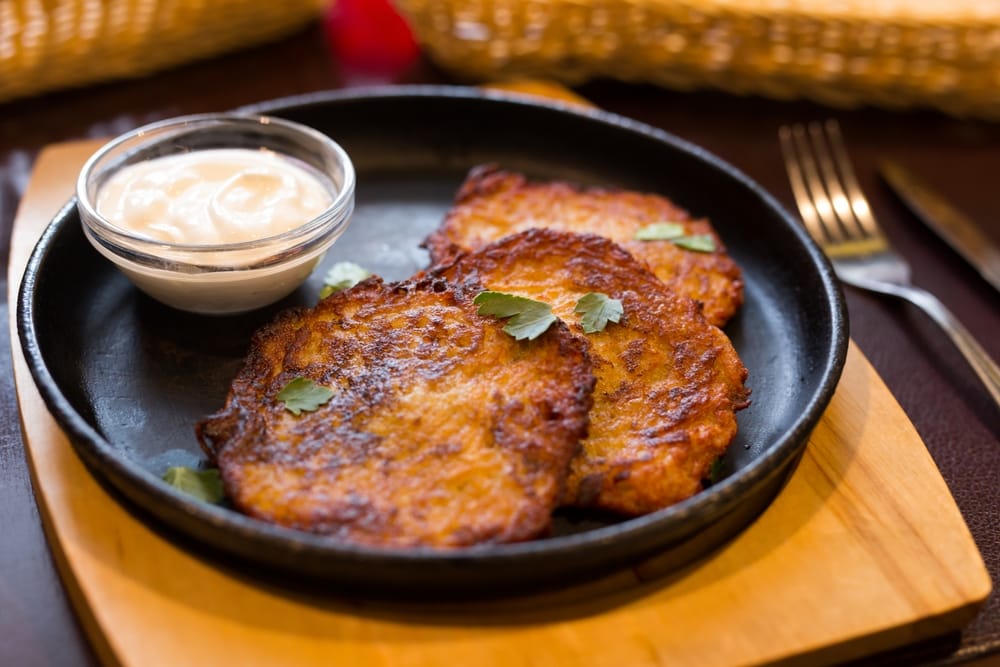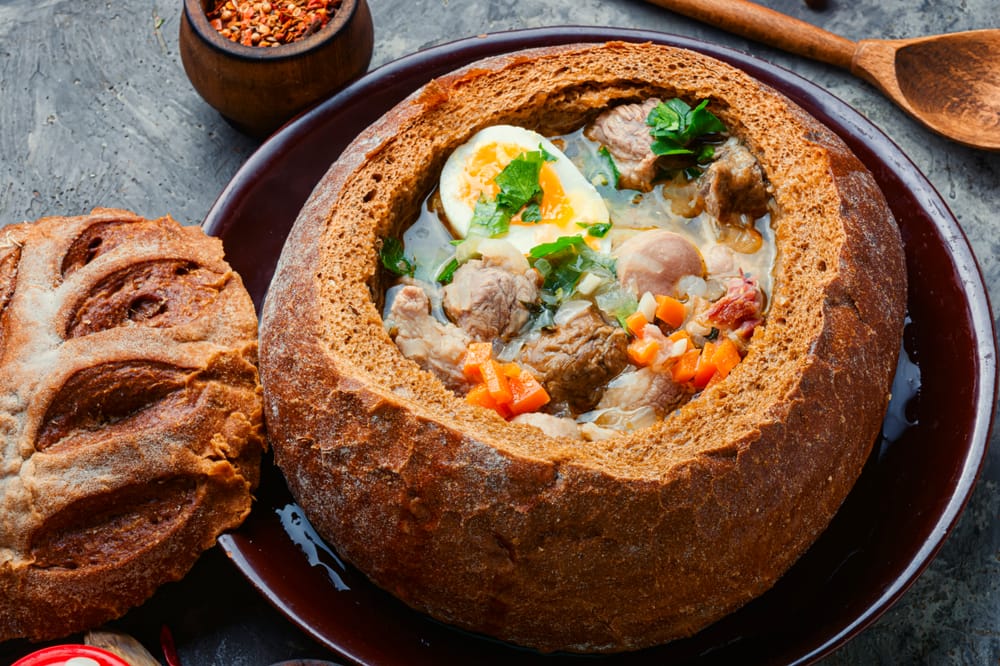Polish food is all about comforting flavors and hearty dishes. Thick, warming, meaty stews are a firm favorite, as well as side dishes made of potatoes cooked every way you can possibly think of! If you are unfamiliar with Polish food, it can feel a little bit daunting trying to navigate the menus. These are some of the foods we think you should make sure you try when you find yourself in Poland!
Bigos

The first on our list of must-try Polish dishes is bigos and this is food at its most comforting. Translated as ‘Hunter’s Stew’, this hearty dish is made from meat, vegetables, and the key ingredient, sauerkraut. Sauerkraut is a side dish of finely chopped cabbage that has then been fermented. Full of goodness, it is great for your gut health, making this dish perfect for anyone looking for Polish food that is both tasty and healthy.
Bigos is traditionally made using beef or pork, with fresh cabbage also added. However, today there are lots of versions available and game meat is popular.
Pierogi

While lots of Polish food has yet to make its way to international tables, pierogis have definitely been a hit with food lovers around the globe. Moon-shaped dumplings, they can be filled with pretty much anything you want. Some of the most traditional fillings are pork cooked with
carrots and onions, mushrooms with sauerkraut, and potato mixed with quark and fried onion (Ruskie). Savory pierogi are usually boiled, but they can also be fried. Expect a good dollop of sour cream and fried onions on the top to finish it off.
Sweet versions are also popular, with blueberries a firm favorite with locals. Quark mixed with sugar and raisin is another traditional take on the sweet pierogi.
Today, you will find pierogis everywhere, with modern restaurants selling some truly maverick fillings, often influenced by dumplings from around the world.
Kotlet Schabowy

Most of Europe has had a love affair with thin slices of meat breadcrumbed and fried, and most countries have their own (and favorite) version. Although the Viennese schnitzel is probably the most popular, Poland’s version can definitely give it a run for its money! Kotlet schabowy (simply schabowy to the locals) is made (unsurprisingly!) with pork instead of veal.
Schabowy is traditionally served with cooked or mashed potatoes, fried mushrooms, cooked vegetables (often cabbage), and coleslaw.
This traditional dish is served across Poland, but if you are after an affordable yet authentic schabowy, try to hunt out a milk bar to try this delicious dish.
(Milk Bars or ‘bar mleczny’, are cheap no-frills restaurants that serve traditional Polish food. They are great places to try a selection of dishes as they are so affordable.)
Zurek

If you were to ask any Polish person what food reminds them of Easter, they would likely say żurek. Also known as ‘zur’, this soup is made using sour rye flour. To this base meat, vegetables, and potatoes are then added and you will often see it served with a boiled egg.
Żurek is one of the oldest Polish dishes and one that can be made in a million different ways. As with most traditional food, every family will have their own and preferred recipe.
If you order this in a restaurant you might see it described as ‘żurek w chlebie.’ This delicious version sees the soup poured into an edible bread bowl. Yes, that’s right, a bowl made of bread!
Placki ziemniaczane

Literally translated as ‘potato pancake’, placki ziemniaczane is a popular yet simple side dish in Poland. There are records of these being eaten by Polish people as far back as the 1600s, so it is definitely a part of Polish history you should try.
Since the 19th century, Poland has suffered a number of economic hardships, when peasants were given the worst crops to eat. To make these taste less awful, they were made into potato pancakes and were often served in place of hard-to-find bread.
Placki ziemniaczane are often topped with sour cream, meat, or mushrooms. There are even sweet versions which see them topped with fresh fruit and fruit syrup drizzled across the top.
Vodka

As one of Poland’s biggest exports, vodka is everywhere in Poland. Distilled with Polish grains (wheat, barley, oats, rye, or triticale) or potatoes, it is now available around the world. Rye vodka is generally considered superior to the others, although flavored vodka is also popular.
The traditional way to drink vodka is neat, without ice or water, not for the faint-hearted! Luckily, most places will offer Polish vodka served with a mixer of your choice or as a cocktail. If you are feeling brave, the traditional way is apparently the best way to appreciate it. Some popular brands to look out for are Żubrówka (rye vodka flavored with bison grass to give it a unique flavor), Luksusowa Vodka (a high-end potato vodka), and Wyborowa Klasyczna (the most popular rye vodka).
Beer

Poland has a long history of brewing beer, and today it is Europe’s third-largest producer (after Germany and the UK). During Communism, all breweries were owned by the state. Since the fall of communism, the industry has grown and thrived. Today, there is a strong microbrewery scene, offering both traditional-style beers and those influenced by international brewing techniques.
It should be noted that beer lovers should consider visiting Poland when the Warsaw Beer Festival is held – which began back in 2014 and has continued since.
Polish beer comes in many styles, but the most popular is lager. This light style of beer is refreshing on a warm summer’s day, with a meal, or any time really! Some popular brands are Lech, Tyskie, Tatra, and Żubr.
Recently, craft beer has taken off in Poland in a big way, with microbreweries popping up in cities across the country. Each city will have its own local brewery so it is worth hunting it down and tasting what Polish brewing has to offer.
Conclusion
Both hearty and healthy, Polish food is comfort food at its finest. Although our list should get you started on your culinary journey of Polish cuisine, there are so many dishes we didn’t have space for! Grab a menu and let yourself be adventurous. You won’t be disappointed.




